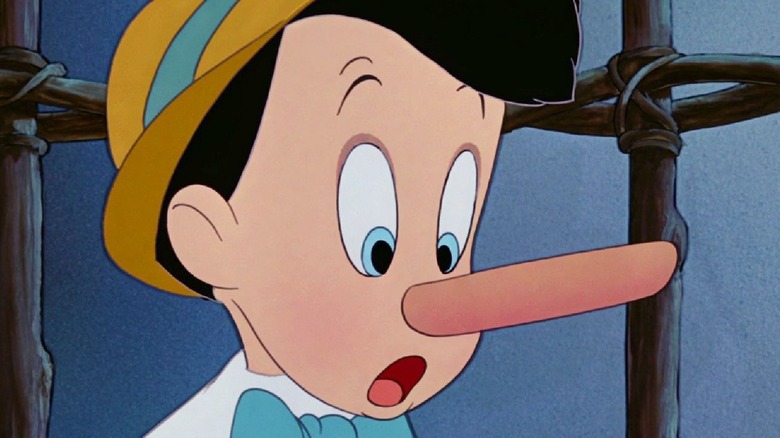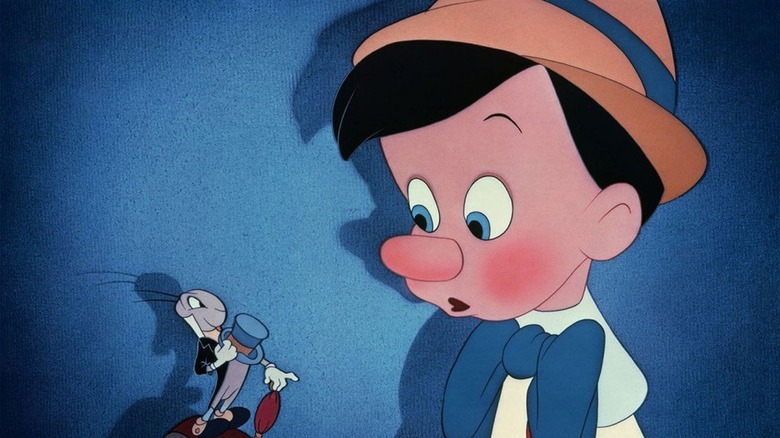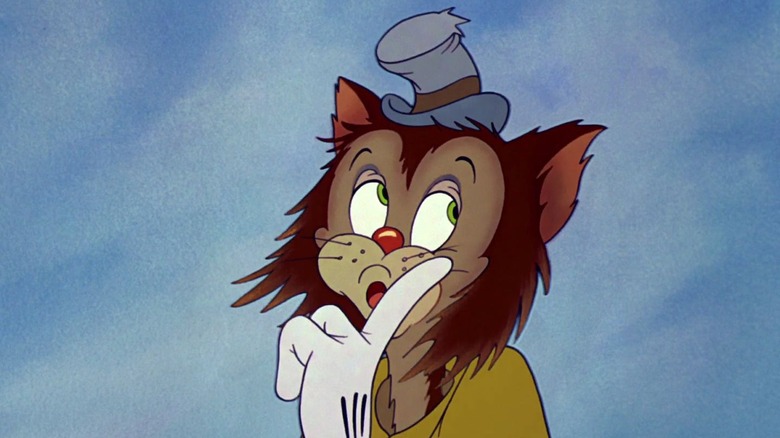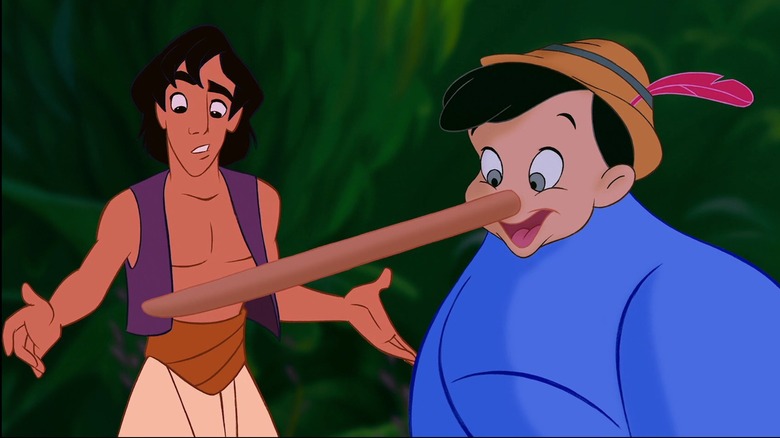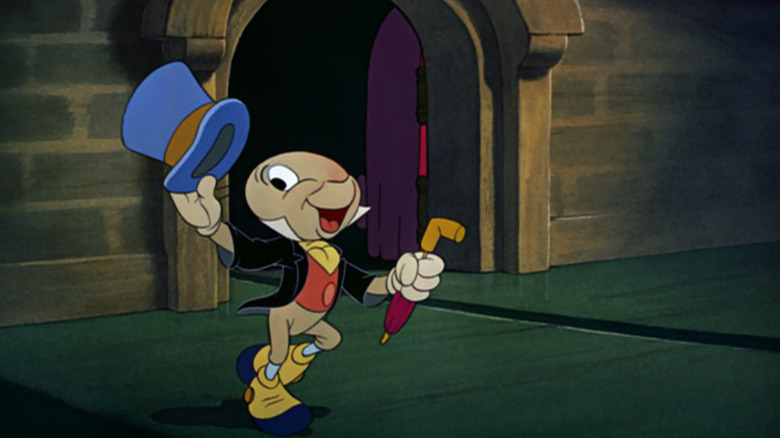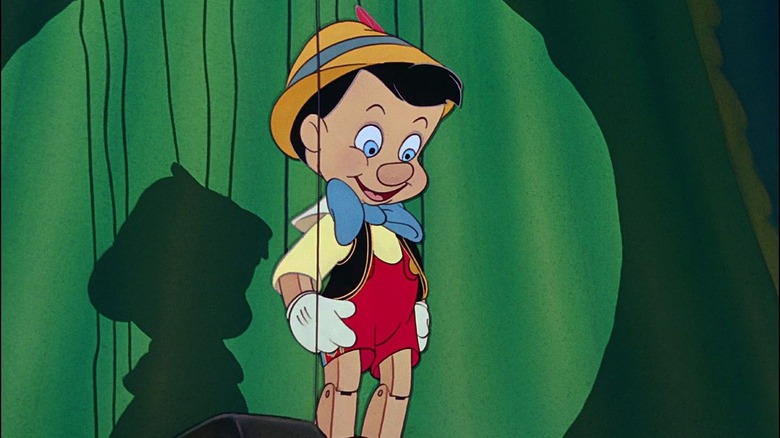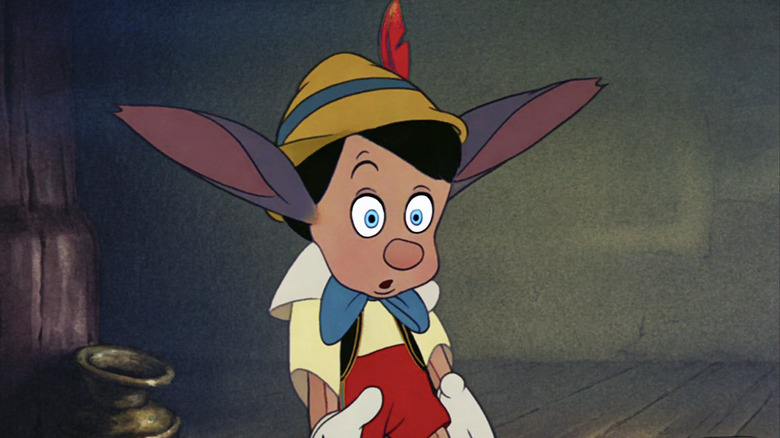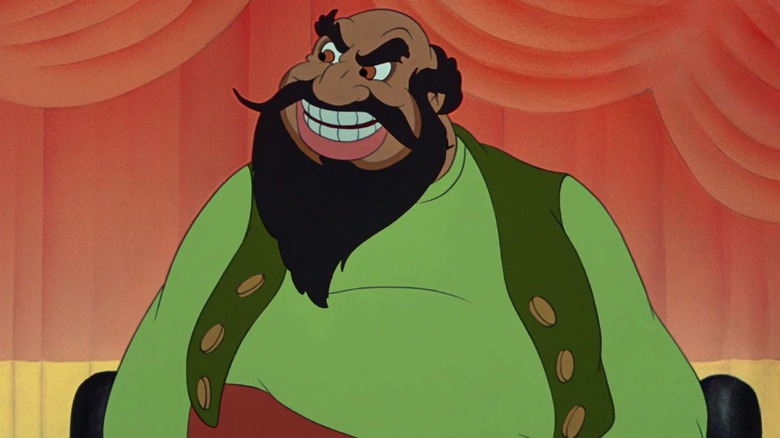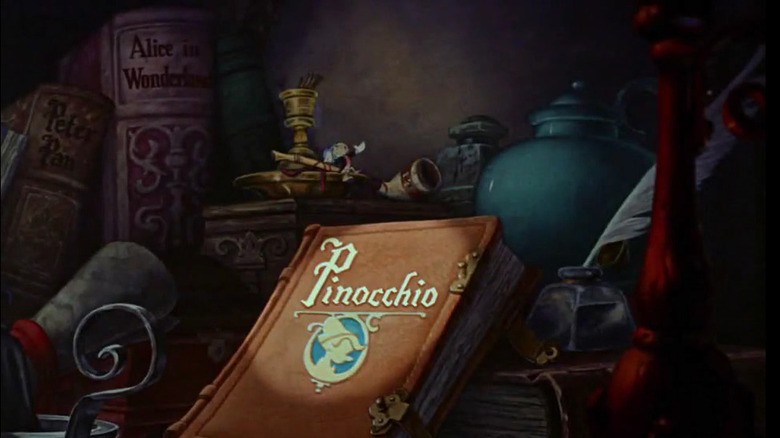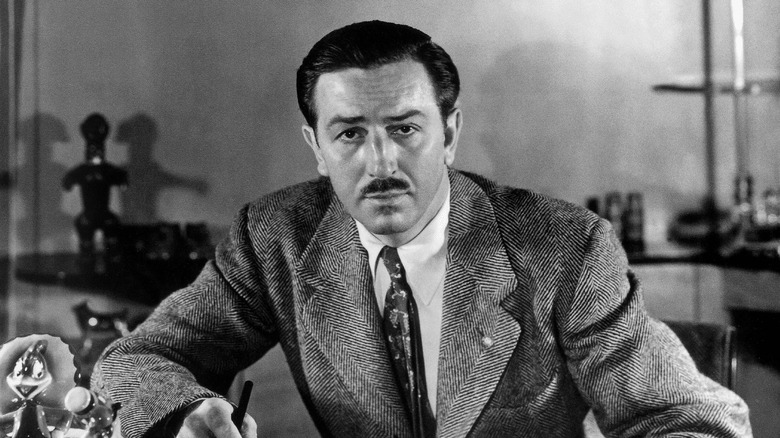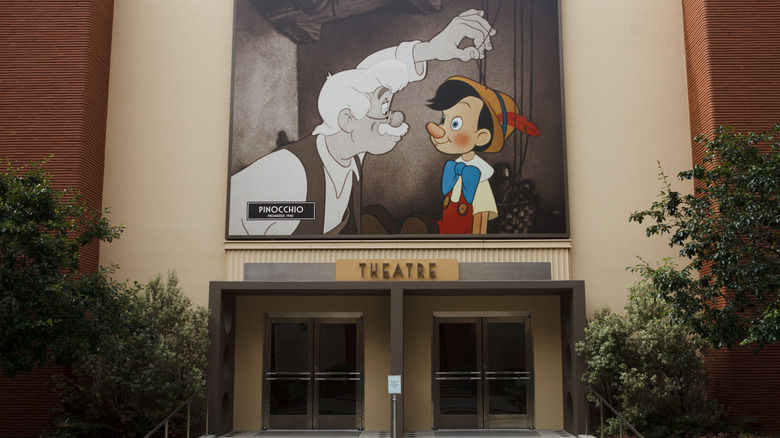The Untold Truth Of Pinocchio
It can be hard to believe that "Pinocchio" –- the second feature film from Disney –- has been around for more than 80 years. Released in February 1940, the enchanting yet dark tale of a puppet who longs to be a real boy has been loved by fans for generations.
The story may have been told many times over, but the animated Disney version has proved to have the most longevity. Hailed by the American Film Institute as one of the finest animated films ever made, "Pinocchio" was even deemed so culturally significant that in 1994 it was added to the United States National Film Registry.
The original review from The Hollywood Reporter in 1940 was full of praise for the film, writing, "In Pinocchio, Disney has so far surpassed all his previous efforts that one wonders to what heights this wizard of entertainment will eventually go." With the gift of hindsight, we can see where the studio ended up -– continuing to delight fans of all ages for decades, and with no signs of stopping.
While countless animated films have followed, "Pinocchio" seems to stick in fans' minds. It has all the elements that make Disney movies magical with memorable songs, adorable characters, and timeless jokes, but it also has a bit of an edge to it. It is one of the darker and more twisted Disney films with scenes that will continue to give you nightmares long into adulthood –- making it is no wonder that this little wooden puppet made such a lasting impression. Here is the untold truth of "Pinocchio."
Pinocchio bombed at the box office
Through no real fault of its own, "Pinocchio" did not perform well at the box office upon its initial release. While the exact figures for the takings at the time are hard to come by, Insider estimates that it grossed somewhere between $1.4 and $1.9 million worldwide. Considering the budget was around $2.3 million, this was an undeniable failure.
The reason was not due to the quality of the film -– quite the opposite in fact, as audiences loved it. However, those who wanted to go and see the film may have struggled to do so, particularly in Europe, as the film's February 1940 release date coincided with the start of World War II. With many theatres closed, the film simply couldn't reach audiences in the way that it should have, and the impact of this was seen at the box office.
World War II continued to affect the studio in the coming years with the studio's output turning towards making propaganda films for the war effort and cheap to produce package films (such as "Saludos Amigos" and "The Three Caballeros") to keep the studio ticking over. After the initial setback for "Pinocchio," it eventually turned a profit, per Box Office Mojo, when it was re-released after the war -– and many times after that for good measure.
Gideon the cat was voiced by a very well-known voice actor
One of the more unique aspects of "Pinocchio" is the fact that it has multiple villains, with Honest John, Stromboli, The Coachman, and Monstro the Whale all trying to impede Pinocchio's journey to becoming a real boy. The sly fox Honest John -– who is anything but honest –- is the first one to appear, and he is ably assisted by his goofy sidekick, Gideon.
A key player in one of the funniest scenes of the film, which involves an oversized mallet, Gideon manages to steal almost every scene he is in without uttering a single word. What is hard to believe is that there is a voice actor credited with this part, even though the audience only ever hears the character hiccup. Even stranger is that the actor credited is Mel Blanc who, if you haven't heard of him, you will have heard of one of the characters he voiced -– including a certain Bugs Bunny, as well as a plethora of other "Looney Tunes" characters.
Known as "The Man of a Thousand Voices," Blanc is an extremely prolific voice actor with a staggering number of screen credits. It may seem strange to have such a well-known voice actor provide the voice for a character who never speaks, although Gideon did originally have some lines that were cut from the final film. The hiccup lives on, however, and it is perhaps the most famous hiccup in animation history, or at least the one provided by the most famous person.
Pinocchio makes an appearance in two other Disney films
As well as cute critters and endlessly singable songs, one of the things Disney has become known for are the Easter eggs hidden within their movies. These small details, featuring nods to previous and future films, give Disney fans something to hunt down, and it can be immensely satisfying when you spot the particularly tricky ones.
Widely regarded as one of the best Disney animated films, Pinocchio naturally makes an appearance in a couple of other Disney films that come along much later. The first is in 1992's "Aladdin," where, amongst many other things, we see the Genie temporarily transform into Pinocchio.
The second one is much harder to spot, but if you hit pause at the right time, you can see Pinocchio tucked away in the Snuggly Duckling pub during the song "I've Got a Dream" from 2010's "Tangled." While things start to unravel the more you think about why there would be a Pinocchio puppet in this pub, the point isn't to question the logic of the Easter eggs but to enjoy the hunt for them. It is always fun to try and pick out these tiny details and is part of why fans can watch Disney films repeatedly.
Jiminy Cricket appears in another Disney film
The wise-cracking sidekick is another staple of the Disney animated films, and the one that set the blueprint for them all was Jiminy Cricket. Acting as Pinocchio's conscience, Jiminy proves to be an essential part of Pinocchio's quest to become a real boy.
Fans hoping for more of the no-nonsense cricket are in luck, as he appears in another Disney film made just seven years later. Disney's war-time output, which started in 1942 and continued until the end of the decade, is often overlooked but is a fascinating period in their history. Animated films can be expensive to make, and when "Pinocchio" and "Fantasia" failed to make an impact at the box office, Disney scaled back to make some cheaper productions that would keep them afloat.
Disney did this by packaging several short films together to make a full feature. One of these films was 1947's "Fun And Fancy Free," where we see Jiminy Cricket a second time. Acting as the host, Jiminy introduces us to two shorts, "Bongo" and "Mickey And The Beanstalk," and even gets to sing a little ditty as well.
"Fun And Fancy Free" is a far cry away from the greatness of "Pinocchio," but it is nice to see Jiminy again, and there's even a little cameo from Gepetto's pet fish, Cleo. However, the very low-budget film managed to turn a profit and helped ensure that Disney could continue making films after the difficult war period ended.
It was the first animated film to win an Academy Award
The first Disney animated feature film, "Snow White And The Seven Dwarves," received an honorary Oscar -– and a very memorable statue –- at the ceremony in 1939. However, it was "Pinocchio" that achieved the incredible feat of being the first animated feature film to win in a competitive category.
"Pinocchio" managed to pick up best original song for "When You Wish Upon A Star" and best original score. By that time, Walt Disney had already received several Oscars for the studio's short films and, in fact, remains the person to have won the most awards of all time, with a staggering 26 wins and 59 nominations, via Time.
This win was so significant for the studio that "When You Wish Upon A Star" was adopted as the anthem of Disney and was used in the Walt Disney Pictures ident that precedes their films from the 1980s onwards. It also heavily features in the Disney theme park shows and parades and is even the sound of the horn on Disney's cruise ships.
Disney would have to wait until the 1960s before the studio picked up this brace of awards again, and they more than doubled their success when the live-action-animation-hybrid "Mary Poppins" took home five awards in total. With the arrival of the Disney Renaissance in 1989 with "The Little Mermaid," Disney's dominance in the best original song category, in particular, was secure for the next decade and beyond.
The original story was much darker than the film
It might be hard to believe, as Disney's "Pinocchio" is still considered one of the scarier animated films, but the original novel "The Adventures of Pinocchio" by Italian author Carlo Collodi is even darker.
In 1881, the novel was published as a serial in a weekly Italian magazine, telling the story of the mischievous marionette, and later published as a single book in 1883. This episodic nature of the original story translates into the film as we see Pinocchio's journey as a series of misadventures, each with a valuable lesson that Pinocchio learns from.
However, there were some major changes from the original story. While Disney's Pinocchio is lovable and cute, this isn't the case in the novel, as he frequently terrorizes Gepetto. Perhaps the most harrowing detail in the original story concerns everyone's favorite sidekick, Jiminy Cricket. In the book, Jiminy is just referred to as the Cricket and only makes a brief appearance before being killed by Pinocchio with a mallet. However, he reappears as a ghost to offer Pinocchio advice –- presumably along the lines of "don't kill crickets who are trying to help." Disney chose to keep the Cricket's efforts to help Pinocchio, taking this small detail and making it the key component of Jiminy's personality, wisely leaving out the murder.
Through the magic of Disney, the film is able to turn some of the darker and more disturbing moments into a wholesome story about a puppet learning to be good so he can become a real boy, making the story much more palatable for audiences.
Supervising animator for villainous Stromboli went on to animate Dumbo
The names of the animators behind some of the best-loved characters in "Pinocchio" may not be well-known, but it is through their creations that their legacy lives on. That is certainly the case with Vladamir "Bill" Tytla. Inducted as a Disney Legend in 1998, the Ukrainian-American animator worked on classics such as "Snow White" and "Fantasia," as well as "Pinocchio."
The book "The Disney Villain" by fellow artists Ollie Johnston and Frank Thomas reflects how Tytla "had earned a reputation for creating powerful characters" and that "Stromboli was one of his greatest." As well as Stromboli –- the villainous puppetmaster in "Pinocchio" -– Tytla also worked on another iconic Disney villain, the terrifying Chernabog from the "Night on Bald Mountain/Ave Maria" sequence from 1940 film "Fantasia."
At the risk of being typecast as an animator of only villains, when it came to his next assignment, Tytla requested a very different character to broaden his resume. As such, he was responsible for bringing the loveable large-eared elephant to life in "Dumbo." The brash Stromboli, imposing Chernabog, and adorable Dumbo, could not be further apart. Still, it goes to show just how talented Tytla was in being able to bring these very different characters to life.
Pinocchio references two yet to be made Disney films
Disney fans know to keep their eyes wide open and always be on the lookout for unexpected hidden details in the films, and "Pinocchio" is no exception. Today it is not uncommon for Disney films to reference upcoming projects, but back in the early years of Disney, there was no guarantee that any of their movies would be a success.
There are two nods in the first scene of "Pinocchio" where we can see future Disney films referenced. As Jiminy Cricket sings "When You Wish Upon A Star," we see the "Pinocchio" storybook below him with two other books on the shelf, "Alice in Wonderland" and "Peter Pan."
It was not uncommon for Disney to be working on multiple projects at once, and both "Alice in Wonderland" and "Peter Pan" were in the pre-production stages prior to "Pinocchio" being released. Referencing these two future films isn't quite as prophetic as it may first appear, as they were clearly projects that Disney was keen to create, and it's a fun detail to include. Disney still had to contend with the difficult war period, so at this stage, neither of these projects was a guarantee. However, it is nice to look back on the film with hindsight and see some of the inner workings of Disney at the time, immortalized in this small "Pinocchio" detail.
Walt Disney was heavily involved in the making of Pinocchio
Until his death in 1966, Walt Disney was always very hands-on in his approach to making films, famously even providing the original voice of Mickey Mouse. When it came to "Pinocchio," Walt was so enthusiastic about the project that he became heavily involved in it.
In the documentary "No Strings Attached," which explores the making of "Pinocchio," animator Ward Kimball recalls that Disney was so invested in the film that he halted production until they could get the character's design right. Fellow animators Ollie Johnston and Frank Thomas, in their book "The Disney Villain," state how the period of working on "Pinocchio" was "the high point of Walt's involvement with animation" and that he was "endlessly creative and completely consumed" with making it.
Walt also pushed for the film to be darker and more suspenseful, reportedly telling his team to "put Pinocchio in the worst places ... Keep the audience worried so they're not bored!" According to those who worked with him, Walt could be a taskmaster and was a notorious perfectionist. Concept artist Gustav Tenggren in the book "They Drew As They Pleased: Vol 1" recalls how Walt "knew how to say, 'No.' The drawings would be torn up and a forest of new drawings would spring up in his face and he would say, 'No' again, louder than before".
Striving for perfection –- particularly when it came to "Pinocchio" -– paid off for Disney. Not only did the film win multiple Oscars, but it is one of the rare films to carry a 100% rating on Rotten Tomatoes. Ultimately, the film built a legacy that Walt Disney could be proud of.
An entirely new process had to be created for complicated shots
Technology in animated films has changed a great deal over the years, and Disney continues to pioneer different techniques to create environments, characters, and movies that capture audiences' imaginations.
The hand-drawn animation techniques of the past may be worlds away from the current computer-animated output from Disney. However, even back then they were inventing new and exciting ways of telling stories, and "Pinocchio" was no exception. For instance, to film the complex overhead shots and sprawling village sequences, Disney developed multiplane cameras that allowed you to feel as if you were traveling into and across scenes.
Today, this could all be done with the click of a button, but the technology was a little more tactile in those days. Disney built huge, multi-story structures housing painted glass panes that the camera could move through to create a sense of depth. There are numerous examples of this in "Pinocchio," such as the scene right before Pinocchio heads off for his first day of school and the overhead shot of him being lured away by Honest John. Just one of these sequences -– which takes up little more than 40 seconds of screentime –- cost $45,000 to make, according to The Walt Disney Family Museum. Adjusted for inflation, that is around $1.8 million today. Disney continued to use this multiplane technique for the features that followed "Pinocchio," and its use changed the perception of animated films being more than just cartoons, but genuine works of art.
The voice actor for Monstro was also Tony the Tiger
One of the most memorable scenes in "Pinocchio" is the showdown with Monstro the Whale. After Pinocchio's brief stint in the theatre and a horrifying time spent on Pleasure Island, the puppet realizes the error of his ways and races home to his father, Gepetto. However, he soon notices that Gepetto is nowhere to be seen and is trapped inside Monstro.
Disney has provided us with many memorable talking animals over the years, and while Monstro might not be one of the most vocal characters, he does have a credited voice artist. Providing the bellows of the giant sea creature is Thurl Ravenscroft, whose booming voice made him the perfect choice. He has several other Disney credits to his name including, "One Hundred and One Dalmatians" and "The Aristocats."
Outside of film, Ravenscroft also voiced characters for Disney's theme park attractions, including "The Haunted Mansion" and "Pirates of the Caribbean." Beyond Disney, however, there is another surprising credit to his name, as he was the uncredited voice of Kellogs Frosted Flakes mascot, Tony the Tiger. Known for his powerful voice, and of course, the catchphrase "They're g-r-r-r-e-a-t!" Tony the Tiger still features heavily in the marketing for the cereal brand. Ravenscroft had previously joked that he'd made his entire career out of one word, but it is quite the legacy as Ravenscroft voiced the mascot from 1953 through to his death in 2005, via the Los Angeles Times.
